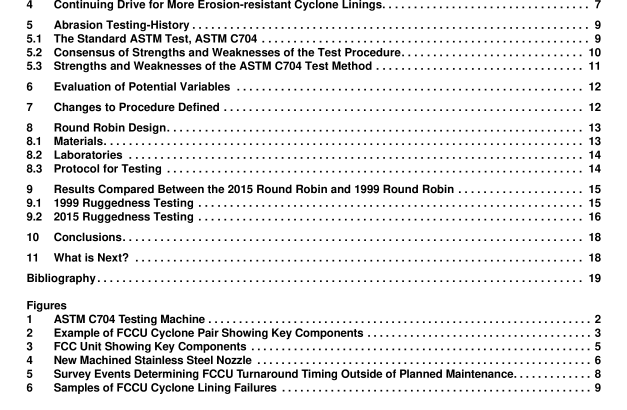API TR 977:2018 pdf free download.ASTM C704 Test Variability Reduced to Allow Further Optimization of Erosion-resistant Refractories for Critical Oil Refining Applications
6 Evaluation of Potential Variables Since 2007, there have been several experiments designed to bring to light the key variables in the test method; they are listed above in the history of ASTM C704 test changes in Table 2. At the 2008 to 201 2 meetings of the ASTM C-08 Refractory Committee and the API Subcommittee on Refractory Materials, test-method variables were discussed, and from those discussions, tests were performed to evaluate those variables, including the following.
— air pressure from 65 psi to 75 psi (4.48 bar to 5.1 7 bar),
— SiC quantities from 2.2 lb to 6.6 lb (1 000 gm to 3000 gm),
— glass tube lengths of 4.5 in. (1 1 5 mm), 9.0 in. (229 mm) (standard length), and 22 in. (559 mm),
— inner diameter (ID) of the glass tubing,
— float glass plate quality—with the float glass specification ASTM C1 036 agreed upon,
— commercial aluminum body grit blasting nozzle/gun versus machined block gun,
— SiC feed system,
— air supply pressure gauges quality and locations,
— vacuum gauge quality,
— calibration of abrasion tester with ASTM C1 036 float glass quality plates,
— variability of cabinets (using 1 versus 2) and variability of different technicians,
— dry air versus non-dry air for testing,
— copper tube versus glass tube.
The results of these independent tests provided a bank of knowledge for manufacturers, testing labs, and end users. These learnings were then discussed and formulated into changes to the testing procedure that were then verified by the results of the subsequent round robin tests.
7 Changes to Procedure Defined
The variables selected for the 201 3 to 201 5 ASTM round robin in the ASTM C704/C704M test method were as follows:
— machined block blast gun design,
— air supply pressure gauges and locations,
— vacuum gauges,
— feeding mechanism,
— abrading media
— calibration of abrasion tester,
— nozzle tube inner diameter,
— dry air supply.
ASTM International sent the testers a reminder of what changes were required to be made, as well as a supplemental procedure for this round robin. For a round robin to depict the true variability of a test method, all labs must follow the procedures exactly, and use the proper test equipment, as outlined in the test method to be evaluated. In some of the previous surveys, it was clear that most of the labs did not follow the ASTM C704 test method when performing the abrasion testing. In this round every effort was made to ensure that every lab followed the correct procedures to the letter. Of the original 39 labs (each tester is defined as an independent lab), only 23 labs followed the procedures specified by the ASTM C704/C704M test procedure and by the supplemental round robin procedures, sent by the ASTM Interlaboratory Study Group.
8 Round Robin Design
The design of the round robin follows the ASTM E691 -09, Standard Practice for Conducting an Interlaboratory Study to Determine the Precision of a Test Method. This practice sets up the materials, test method, and labs so that its use in the precision of the test method can be accurately determined.
The two measures of precision are 1 ) repeatability, which measures the precision of an individual lab and 2) reproducibility, which measures what precision might be expected when random samples of a homogeneous material are sent to random laboratories that are seen to be “in-control.” For clarification, the following are key definitions: — Repeatability conditions: conditions where independent test results are obtained with the same test method on identical test items in the same laboratory by the same operator using the same equipment within short intervals of time. — Reproducibility conditions: conditions where test results are obtained with the same method on identical test items in different laboratories with different operators using different equipment. In summation, ASTM E691 -09 requires that all the labs follow the exact same procedure, using the same materials, following all the special protocols set up by the Interlaboratory Study (ILS) group.
8.1 Materials
During one of the API Subcommittee on Refractory Materials meetings, three refractory manufacturers were randomly chosen to manufacture three different types of castable refractories to be tested in the round robin. Once these three manufacturers were chosen, another random selection was done to assign the type of castable that each manufacturer would produce for this round robin.API TR 977 pdf download.API TR 977:2018 pdf free download
